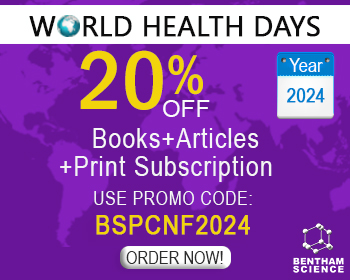Abstract
Background: Recently, in the medical and pharmaceutical fields, biopolymers are extensively used for chemical and mechanical modifications of pharmaceutical dosage forms, which add novel properties, functions, and applications. Structural modification of dosage form by polymers along with redesigning in pharmaceutical and tissue engineering fields, presently being the center of analysis for the modern research world, which utilizes the subtle instruments, precise research strategies and most significantly the excipients.
Method: The polymer, chitosan, which is a natural linear polysaccharide composed of randomly distributed β-(1- 4)-linked D-Glucosamine and N-acetyl-D-Glucosamine units. Chitosan has been used by researchers as a network forming or gelling agent as chitosan is economically available, possesses low immunogenicity, biocompatibility, non-toxicity, biodegradability, protects against secretion from irritation and does not suffer the danger of transmission animal infective agent. Recent studies have proved that the chitosan conjugated in various biopharmaceutical drug formulations, such as nanoparticles, have been used for the treatment of breast, skin, colon, pancreatic, prostate and lung cancer. The nanoparticles have gained significant attention of scientific groups for relevant cancer-targeting drugs and dosage form. In this connection, several articles been published on chitosan anchored nanoparticles by suitable techniques, such as ion gelation, complexation, solvent evaporation, emulsion droplet coalescence and polymerization. Results: The most remarkable point is that chitosan-drug conjugated nanoparticles (CDNP) can target cancer affected cells with the least attempt to killing the neighbor host cell. It is already proved that the CDNP facilitate the more drugs uptaking or cytotoxicity to a cancerous cell. This overcomes the dosage form designing problems of complexity in the biological mechanism and cell specificity. A computer-aided pharmacokinetic study as well as in-silico design with model fitting can provide the possible finding related to target selectivity and interaction. The computer aided study also reduces time and could make the entire process much cheaper till today, very few research has been reported, such as PyRx with AutoDock, response surface methodology and molecular dynamic simulation in drug delivery for chitosan-drug conjugated nanoparticles. Conclusion: Therefore, cancer cell target-specific drug delivery using a natural biopolymer conjugate with a computer-aided pharmacokinetic model will be the thirst area of future research. To get successful anticancer drug formulation, in-silico pharmacokinetic modeling would minimize labor, and expenses, during and prior to the experiment has been extensively discussed in the present review.Keywords: Natural biopolymer, chitosan, conjugated nanoparticle drug development, bone repair, cancer treatment, in-silico pharmacokinetic modeling.
[http://dx.doi.org/10.3390/coatings9030194]
[PMID: 27819009]
[PMID: 19484769]
[http://dx.doi.org/10.1016/j.ijpharm.2003.12.026] [PMID: 15072779]
[http://dx.doi.org/10.1016/j.mspro.2014.07.062]
[http://dx.doi.org/10.1016/j.ijbiomac.2016.02.035] [PMID: 26893051]
[http://dx.doi.org/10.1016/j.carbpol.2016.05.049] [PMID: 27474556]
[http://dx.doi.org/10.1016/j.biomaterials.2013.09.012] [PMID: 24074837]
[http://dx.doi.org/10.1016/j.carbpol.2016.07.033] [PMID: 27516289]
[http://dx.doi.org/10.1016/j.ejbt.2016.10.006]
[http://dx.doi.org/10.1016/j.eurpolymj.2012.12.009]
[http://dx.doi.org/10.1021/nn504573u] [PMID: 25602381]
[http://dx.doi.org/10.1016/j.canlet.2008.08.014] [PMID: 18809246]
[http://dx.doi.org/10.1016/j.biotechadv.2014.07.007] [PMID: 25109677]
[http://dx.doi.org/10.1016/j.carbpol.2015.05.027] [PMID: 26076619]
[http://dx.doi.org/10.1016/j.carbpol.2016.05.028] [PMID: 27312632]
[http://dx.doi.org/10.1016/j.jssas.2016.04.001]
[http://dx.doi.org/10.1016/j.carbpol.2016.09.085] [PMID: 27987946]
[http://dx.doi.org/10.1016/j.cis.2015.03.003] [PMID: 25865361]
[http://dx.doi.org/10.1016/j.apsb.2012.07.004]
[http://dx.doi.org/10.1166/jbn.2016.2228] [PMID: 29341581]
[http://dx.doi.org/10.3390/molecules23102661] [PMID: 30332830]
[http://dx.doi.org/10.1080/17425247.2016.1178232] [PMID: 27087148]
[http://dx.doi.org/10.1016/j.ijbiomac.2016.07.003] [PMID: 27381584]
[http://dx.doi.org/10.2174/1871520618666180412114352] [PMID: 29651963]
[http://dx.doi.org/10.1016/j.ijbiomac.2016.07.025] [PMID: 27693338]
[http://dx.doi.org/10.1016/j.jcis.2016.02.043] [PMID: 26939078]
[http://dx.doi.org/10.1016/j.jmmm.2016.07.066]
[http://dx.doi.org/10.1016/j.jphotobiol.2014.08.005] [PMID: 25190225]
[http://dx.doi.org/10.1016/j.msec.2016.08.054] [PMID: 27770872]
[http://dx.doi.org/10.1016/j.actbio.2016.10.012] [PMID: 27729232]
[http://dx.doi.org/10.1016/j.msec.2016.09.003]
[http://dx.doi.org/10.1016/j.msec.2016.11.014] [PMID: 27987679]
[http://dx.doi.org/10.1016/j.biopha.2016.06.026] [PMID: 27470566]
[http://dx.doi.org/10.1016/j.carbpol.2012.04.050] [PMID: 24750892]
[http://dx.doi.org/10.1016/j.colsurfb.2015.08.038] [PMID: 26340358]
[http://dx.doi.org/10.1016/j.ejca.2006.08.029] [PMID: 17049839]
[http://dx.doi.org/10.1016/j.jddst.2015.10.004]
[http://dx.doi.org/10.1016/j.ejps.2012.09.012] [PMID: 23041219]
[http://dx.doi.org/10.1016/j.lfs.2012.09.015] [PMID: 23044224]
[http://dx.doi.org/10.1016/S2222-1808(12)60262-X]
[http://dx.doi.org/10.1016/j.ijbiomac.2014.08.027] [PMID: 25175732]
[http://dx.doi.org/10.1016/j.jsps.2016.04.008] [PMID: 27275110]
[PMID: 24106427]
[http://dx.doi.org/10.1166/jbn.2013.1558] [PMID: 23620988]
[PMID: 21976973]
[http://dx.doi.org/10.1088/2043-6262/4/2/025001]
[http://dx.doi.org/10.1016/j.canlet.2011.06.022] [PMID: 21840122]
[http://dx.doi.org/10.1016/j.nano.2010.01.011] [PMID: 20172052]
[http://dx.doi.org/10.1016/j.nano.2009.03.002] [PMID: 19447205]
[http://dx.doi.org/10.2147/IJN.S39615] [PMID: 23589688]
[http://dx.doi.org/10.1016/j.ijpharm.2012.08.008] [PMID: 22909993]
[http://dx.doi.org/10.1016/j.eswa.2018.12.032]
[http://dx.doi.org/10.1016/j.sbi.2016.10.007] [PMID: 27816785]
[http://dx.doi.org/10.2174/0929867003375317] [PMID: 10637360]
[http://dx.doi.org/10.1007/978-1-61779-965-5_6]
[http://dx.doi.org/10.1016/j.molstruc.2019.04.023]
[http://dx.doi.org/10.1155/2016/1087250] [PMID: 27398083]
[http://dx.doi.org/10.1080/10715760500104025] [PMID: 16036346]
[http://dx.doi.org/10.1007/s00280-013-2179-9] [PMID: 23670640]
[http://dx.doi.org/10.1080/10837450802288865] [PMID: 18720244]
[http://dx.doi.org/10.1016/j.jiec.2018.01.001]
[PMID: 19499576]
[http://dx.doi.org/10.1016/j.carbpol.2017.10.102] [PMID: 29279114]
[http://dx.doi.org/10.1016/j.jcis.2011.04.006] [PMID: 21549390]
[http://dx.doi.org/10.1021/bi400779r] [PMID: 23834496]
[PMID: 1384144]
[http://dx.doi.org/10.1016/j.biocel.2017.02.001] [PMID: 28167289]
[http://dx.doi.org/10.3389/fphar.2015.00272] [PMID: 26617524]
[http://dx.doi.org/10.1099/mic.0.062190-0] [PMID: 22956757]
[http://dx.doi.org/10.1007/BF02931286] [PMID: 12744087]
[http://dx.doi.org/10.1073/pnas.052709699] [PMID: 11880624]
[http://dx.doi.org/10.2174/138920109787048643] [PMID: 19149591]
[http://dx.doi.org/10.1016/j.bbamem.2006.03.037] [PMID: 16806056]
[http://dx.doi.org/10.1139/w04-019] [PMID: 15213746]
[http://dx.doi.org/10.1016/0304-4165(80)90039-2] [PMID: 6256005]
[http://dx.doi.org/10.1007/s00253-013-4926-6] [PMID: 23644748]
[http://dx.doi.org/10.1007/s10456-011-9220-6] [PMID: 21667138]
[http://dx.doi.org/10.1038/nature26140] [PMID: 29562234]
[http://dx.doi.org/10.5301/jabfm.5000278] [PMID: 27647390]
[http://dx.doi.org/10.1016/S0169-409X(01)00180-6] [PMID: 11576697]
[PMID: 19597323]
[PMID: 20044623]
[http://dx.doi.org/10.3762/bjnano.7.178] [PMID: 28144535]
[http://dx.doi.org/10.3390/ijms12010266] [PMID: 21339986]



























